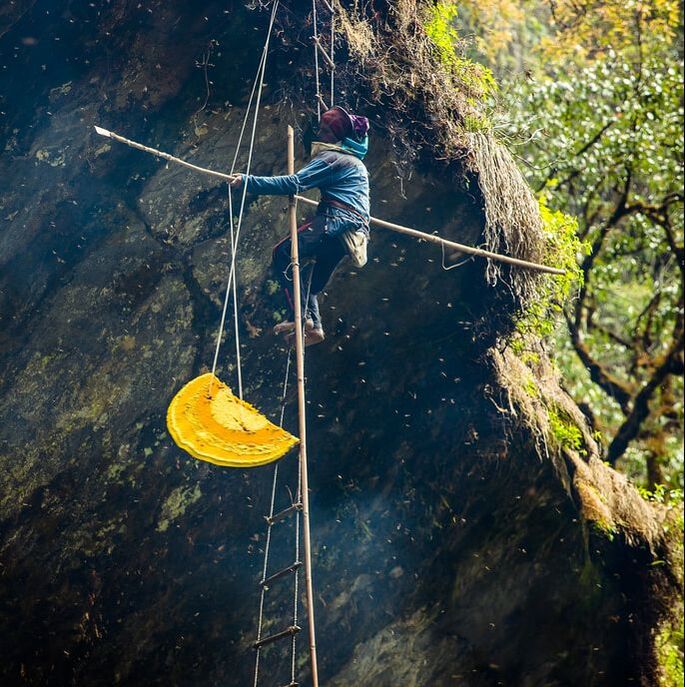The Gurung people live on the slopes of the Annapurna and Lamjung Himalayan mountains, between 1000 and 2000 m in altitude, and have a tradition that has been carried on for generations: Honey hunting. Honey hunting is a dangerous ritual during which hunters climb the cliffs on hand-woven rope ladders. They use long sticks, also called tangos, to access the honey bees' nests, which are located on steep, inaccessible cliffs. Before collecting the honey, the bees, Apis laboriosa, the largest honeybee in the world, are sedated with smoke. But of course, many hunters still get stung. Honey hunting is a collective practice with different responsibilities and tasks assigned to the participants. While only a few men actually hunt, others have to oversee the fires or catch and transport the honey.
The practice of honey hunting also has a religious significance for the Gurung. Before the honey hunt begins, the hunters perform a ceremony in which they sacrifice a sheep and offer flowers, fruits and rice to the cliff gods. They make a special appeal to Rangkemi, the guardian spirit of bees and of difficult, dangerous places. The honey itself is used in various meals, as a cough syrup, and as an antiseptic.
The practice of honey hunting also has a religious significance for the Gurung. Before the honey hunt begins, the hunters perform a ceremony in which they sacrifice a sheep and offer flowers, fruits and rice to the cliff gods. They make a special appeal to Rangkemi, the guardian spirit of bees and of difficult, dangerous places. The honey itself is used in various meals, as a cough syrup, and as an antiseptic.
|
Traditionally, honey hunting was practiced only once or twice a year and responsible hunters would ensure to leave plenty of honey for the bees to repopulate for future years. However, recent developments have changed that: more and more tourists are coming to the region to observe honey hunting. Tour operators have built a lucrative business, pressuring the often poor hunters to climb up their ladders regularly. Another threat comes from the growing medical reputation of Himalayan honey, which is exported and used in traditional Japanese, Chinese, and Korean medicine. The pink spring honey is particularly sought after. Its colour and psychotropic effects result from toxins in the flowers of the rhododendron trees, which is plentiful for bees to feed on in the spring months. The increasing demand has also drawn the government's attention to the remote cliffs, and more and more contractors move into the area to harvest the honey. Together with the dwindling interest of the younger generation to continue the practices, these modern developments could soon lead to the end of this ancient tradition.
|

